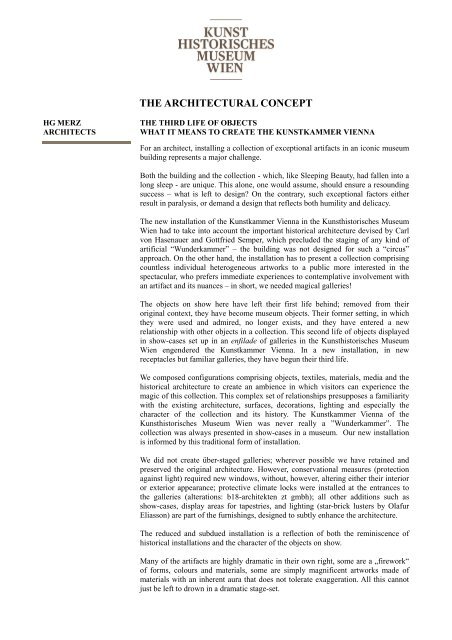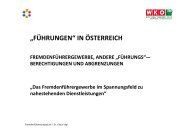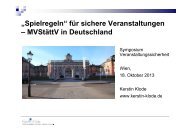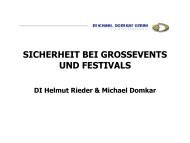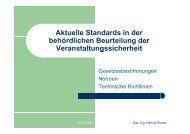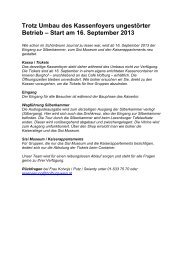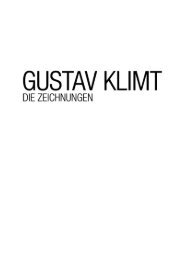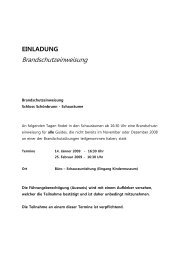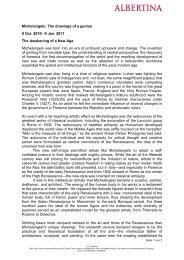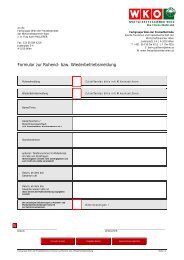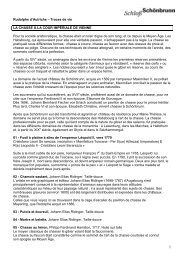kunstkammer vienna the cradle of the museum - Freizeitbetriebe ...
kunstkammer vienna the cradle of the museum - Freizeitbetriebe ...
kunstkammer vienna the cradle of the museum - Freizeitbetriebe ...
Create successful ePaper yourself
Turn your PDF publications into a flip-book with our unique Google optimized e-Paper software.
HG MERZ<br />
ARCHITECTS<br />
THE ARCHITECTURAL CONCEPT<br />
THE THIRD LIFE OF OBJECTS<br />
WHAT IT MEANS TO CREATE THE KUNSTKAMMER VIENNA<br />
For an architect, installing a collection <strong>of</strong> exceptional artifacts in an iconic <strong>museum</strong><br />
building represents a major challenge.<br />
Both <strong>the</strong> building and <strong>the</strong> collection - which, like Sleeping Beauty, had fallen into a<br />
long sleep - are unique. This alone, one would assume, should ensure a resounding<br />
success – what is left to design? On <strong>the</strong> contrary, such exceptional factors ei<strong>the</strong>r<br />
result in paralysis, or demand a design that reflects both humility and delicacy.<br />
The new installation <strong>of</strong> <strong>the</strong> Kunstkammer Vienna in <strong>the</strong> Kunsthistorisches Museum<br />
Wien had to take into account <strong>the</strong> important historical architecture devised by Carl<br />
von Hasenauer and Gottfried Semper, which precluded <strong>the</strong> staging <strong>of</strong> any kind <strong>of</strong><br />
artificial “Wunderkammer” – <strong>the</strong> building was not designed for such a “circus”<br />
approach. On <strong>the</strong> o<strong>the</strong>r hand, <strong>the</strong> installation has to present a collection comprising<br />
countless individual heterogeneous artworks to a public more interested in <strong>the</strong><br />
spectacular, who prefers immediate experiences to contemplative involvement with<br />
an artifact and its nuances – in short, we needed magical galleries!<br />
The objects on show here have left <strong>the</strong>ir first life behind; removed from <strong>the</strong>ir<br />
original context, <strong>the</strong>y have become <strong>museum</strong> objects. Their former setting, in which<br />
<strong>the</strong>y were used and admired, no longer exists, and <strong>the</strong>y have entered a new<br />
relationship with o<strong>the</strong>r objects in a collection. This second life <strong>of</strong> objects displayed<br />
in show-cases set up in an enfilade <strong>of</strong> galleries in <strong>the</strong> Kunsthistorisches Museum<br />
Wien engendered <strong>the</strong> Kunstkammer Vienna. In a new installation, in new<br />
receptacles but familiar galleries, <strong>the</strong>y have begun <strong>the</strong>ir third life.<br />
We composed configurations comprising objects, textiles, materials, media and <strong>the</strong><br />
historical architecture to create an ambience in which visitors can experience <strong>the</strong><br />
magic <strong>of</strong> this collection. This complex set <strong>of</strong> relationships presupposes a familiarity<br />
with <strong>the</strong> existing architecture, surfaces, decorations, lighting and especially <strong>the</strong><br />
character <strong>of</strong> <strong>the</strong> collection and its history. The Kunstkammer Vienna <strong>of</strong> <strong>the</strong><br />
Kunsthistorisches Museum Wien was never really a ”Wunderkammer”. The<br />
collection was always presented in show-cases in a <strong>museum</strong>. Our new installation<br />
is informed by this traditional form <strong>of</strong> installation.<br />
We did not create über-staged galleries; wherever possible we have retained and<br />
preserved <strong>the</strong> original architecture. However, conservational measures (protection<br />
against light) required new windows, without, however, altering ei<strong>the</strong>r <strong>the</strong>ir interior<br />
or exterior appearance; protective climate locks were installed at <strong>the</strong> entrances to<br />
<strong>the</strong> galleries (alterations: b18-architekten zt gmbh); all o<strong>the</strong>r additions such as<br />
show-cases, display areas for tapestries, and lighting (star-brick lusters by Olafur<br />
Eliasson) are part <strong>of</strong> <strong>the</strong> furnishings, designed to subtly enhance <strong>the</strong> architecture.<br />
The reduced and subdued installation is a reflection <strong>of</strong> both <strong>the</strong> reminiscence <strong>of</strong><br />
historical installations and <strong>the</strong> character <strong>of</strong> <strong>the</strong> objects on show.<br />
Many <strong>of</strong> <strong>the</strong> artifacts are highly dramatic in <strong>the</strong>ir own right, some are a „firework“<br />
<strong>of</strong> forms, colours and materials, some are simply magnificent artworks made <strong>of</strong><br />
materials with an inherent aura that does not tolerate exaggeration. All this cannot<br />
just be left to drown in a dramatic stage-set.


